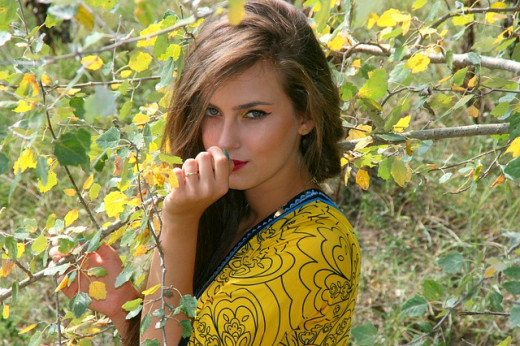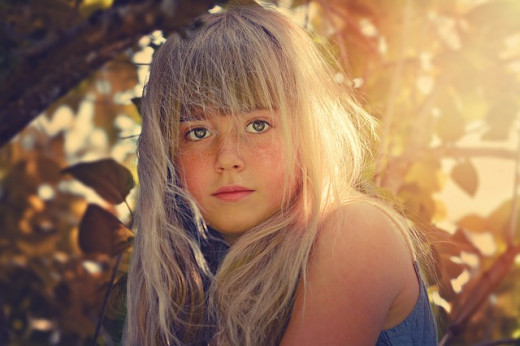Tips for Better Portraits

Matching colors can add appeal

Most if not all photographers will take someone's portraits at one time or another. Perhaps it is to make some easy cash, perhaps it is to make someone in your family happy or simply because you are asked to do it or maybe even because this is what you like to do with your photographic talents.
No matter the reason portraits are a staple in the photo business and making good portraits is not only one of the easiest ways of learning the craft but of also constantly practicing something that you like doing which in turn keeps you photographing all year round.
One of the first things that you need to do is to get a 50mm prime lens. It is not an expensive lens and many camera manufacturers often include this lens with their camera as a starter lens.
The good thing about these lenses is that they often allow you to set a low f stop and a low f stop number also allows you to blur most of the background thus concentrating most of the attention on the subject which in turn makes the portrait stand out.
A 50mm prime lens is probably the best lens to have in your bag in order to start getting better and enhancing you photo experience.
Hair highlights can be dramatic elements

Pets can steal the show but are always good props

When taking a portrait focus on the eyes. If the eyes are in focus and show up sharply then your portrait stands out and draws attention to it.
If you can focus on the eyes do so manually. The camera auto mode will focus on the entire face evenly and may render the eyes slightly out of focus. The eyes must be the most prevalent and sharpest element in any portrait.
Get this right and you are already on your way to capturing great portraits. Do not forget that the human brain instantly focuses on the eyes first and then on the rest of the elements in any scene.
Nature photographers who make a living photographing animals always focus on the eyes first and the rest of the subject later. If they cannot get the eyes to appear sharply in their images they often forgo the photo op in order to get better shot where they can get the eyes of their subject in sharp focus.
Try to correct any issues while taking the picture rather than afterwards using a photo manipulation program like Photoshop. The effects are never as good as getting it right with the camera in the first place.
Profile views can work too

Try shooting using angles and perspectives that are not the usual ones. Include portions of the scenery to tell a story. Try low angles, high angles and everything in between. Get in close with the lens even if you have to physically get super close to the face of your subject. It is OK to include the main parts of a face and even cut the top half of the head.
Really close looks into a human face brings out a very interesting perspective that many of us are not accustomed to seeing.
Look at the work of some of the best professional photographers whether they shoot animals or people. You will often see really close looks that mainly focus solely on the main parts of a face and there is a reason why these professionals do this intentionally; because people look at these elements first and these are what call the attention of the viewer.

Did these tips help you understand how to make a better portrait?
Good props can enhance the experience & tell a story

Think outside the box and be creative

Get to know your subject and find out what their interests are. Including some elements that show what your subject likes makes anyone who looks at the portrait and happens to know something about your subject really relate to the photograph.
Posing and including appropriate props really helps the overall feel of the shot and goes a long way in showing more about your subject than taking a picture where your subject is simply posed against a flat or plain backdrop like most typical studio cloth or paper backdrops.
You job is to truly capture the essence of who the person really is and this makes your shots stand out and be interesting.
You do not need to capture every image in color. Sometimes a portrait looks best in black and white. The lack of color serves to bring all the attention to the features and details of a subject and if the features are strong ones or if the composition is a pleasant one, then removing color can be very effective.
Good pose and use of the setting


First and foremost pay attention to the light. The subject's face area needs to be exposed properly even if the rest of the scene, including the backdrop, lacks proper illumination. The face is the most important element in the shot and everything else then becomes secondary.
Try to take you shots during overcast days when the light is softer and you avoid creating harsh shadows and light hot spots that can become present if you photograph during the midday hours or during very sunny days.
Also very important when doing portraits is to avoid letting strong light fall on the subject's face. Squinting of the eyes, shadows under the nose area and under the chin can be distractions that take away from the overall effect. This is especially true if the light source is above the subject's head.
Strong Sunlight can create harsh shadows and squinting.

Finally learn the most basic rules of photography.
Following them leads you to improve your shots. Breaking them and trying out new things leads you to make good shots even better.
These rules are meant to give anyone just beginning a good solid starting point but as you improve your techniques and get to master your equipment, going away from the rules is what makes your shots stand out and be more interesting.
Good selection & placement of depth of field elements

© 2015 Luis E Gonzalez









